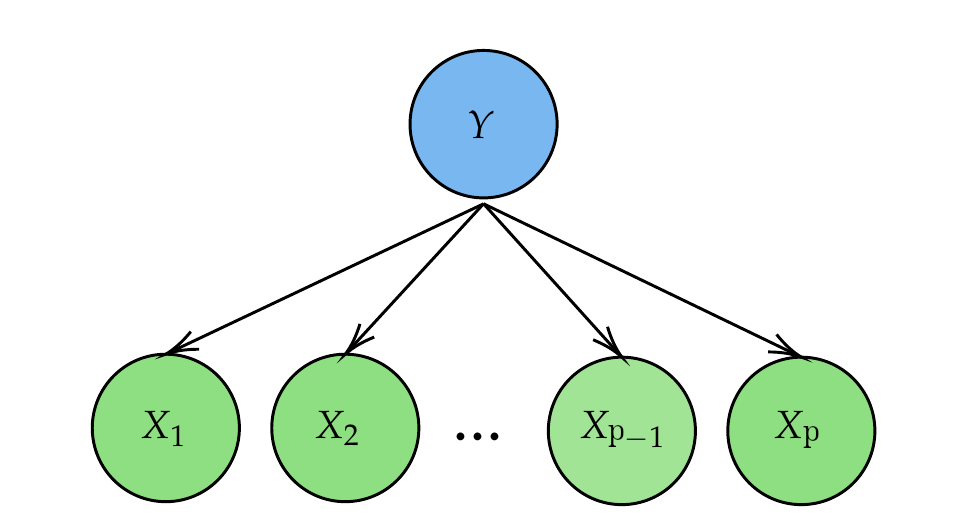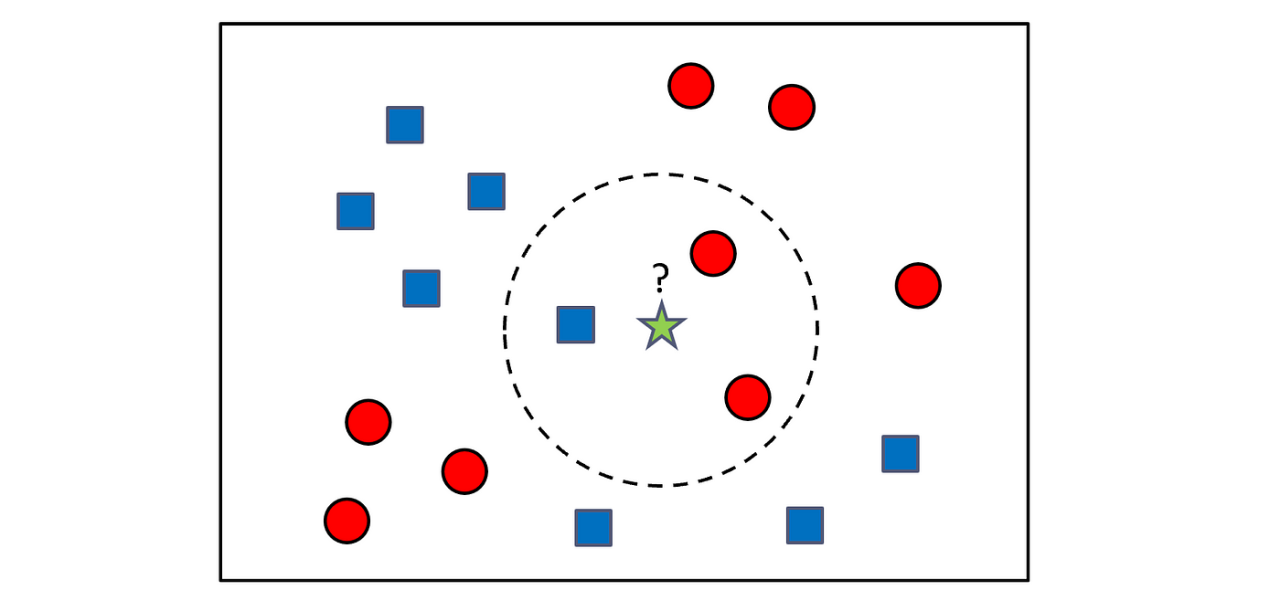Statistical Machine Learning
Classification Methods
UFPE
Notation
- \(X\) or \(Y\)
- \(x\) or \(y\)
- \(\mathbf{x}\) or \(\mathbf{y}\)
- \(\dot{\mathbf{x}}\) or \(\dot{\mathbf{y}}\)
- \(\mathbf{X}\) or \(\mathbf{Y}\)
- \(\dot{\mathbf{X}}\) or \(\dot{\mathbf{Y}}\)
- \(p\)
- \(n\)
- \(i\)
- \(j\)
- \(k\)
represent random variables (r.v.);
represent realizations of random variables;
represent random vectors;
represent realizations of random vectors;
represent random matrices;
represent realizations of random matrices;
dimension of features, variables, parameters
sample size
\(i\)-th observation, instance (e.g., \(i=1, ..., n\))
\(j\)-th feature, variable, parameter (e.g., \(j=1, ..., p\))
number of folds in k-fold CV
Remembering: Risk Function
- Assume \(Y\) takes values in a set \(\mathcal{C}\) (e.g., \(\mathcal{C} = \{\text{spam, not spam}\}\)).
- The regression risk function \(R(\hat{f}) = E[(Y - \hat{f}(\mathbf{x}))^2]\) is not suitable for classification (what would \(Y - \hat{f}(\mathbf{x})\) mean?).
- A common risk function for classification is the 0-1 loss:
\[R(f) := E[I(Y \neq \hat{f}(\mathbf{x}))] = P(Y \neq \hat{f}(\mathbf{x}))\]
- This is the probability of misclassification.
- The loss function is
\[L(\hat{f}(\mathbf{x}), Y) = I(Y \neq \hat{f}(\mathbf{x}))\]
Optimal Classifier
Bayes Classifier
- In regression, \(\hat{f}(\dot{\mathbf{x}}) = E[Y|\mathbf{x}=\dot{\mathbf{x}}]\) minimizes \(E[(Y - \hat{f}(\mathbf{x}))^2]\).
- For classification, the function \(f\) that minimizes the 0-1 risk is given by: \[\hat{f}(\dot{\mathbf{x}}) = \underset{c \in \mathcal{C}}{\text{arg max }} P(Y=c|\mathbf{x}=\dot{\mathbf{x}})\]
- This means \(\dot{\mathbf{x}}\) should be classified to the class with the highest posterior probability.
- This is known as the Bayes classifier.
- Like \(E[Y|\mathbf{x}=\dot{\mathbf{x}}]\) in regression, \(P(Y=c|\mathbf{x}=\dot{\mathbf{x}})\) is generally unknown.
Bayes Classifier
Theorem: Suppose we define the risk of a prediction function \(\hat{f}: \mathbb{R}^p \to \mathcal{C}\) via 0-1 loss: \(R(\hat{f}) = P(Y \neq \hat{f}(\mathbf{x}))\), where \((\mathbf{x},Y)\) is a new observation not used to estimate \(\hat{f}\).
Then the function \(\hat{f}\) that minimizes \(R(\hat{f})\) is given by
\[\hat{f}(x) = \underset{c \in \mathcal{C}}{\text{arg max }} P(Y=c|\mathbf{x}=\dot{\mathbf{x}})\]
Demonstration - Binary Case
- Assume \(Y\) takes two values, \(c_1\) and \(c_2\) (binary problem).
\[\begin{align} R(\hat{f}) = & E[I(Y \neq \hat{f}(\mathbf{x}))] = P(Y \neq \hat{f}(\mathbf{x})) \\ = & \int_{\mathbb{R}^p} P(Y \neq \hat{f}(\mathbf{x})|\mathbf{x}=\dot{\mathbf{x}})f(\mathbf{x})d\mathbf{x} \\ = & \int_{\mathbb{R}^p} [I(\hat{f}(\mathbf{x})=c_2)P(Y=c_1|\mathbf{x}=\dot{\mathbf{x}}) +\\ & I(\hat{f}(\dot{\mathbf{x}})=c_1)P(Y=c_2|\mathbf{x}=\dot{\mathbf{x}})]f(\mathbf{x})d\mathbf{x} \end{align}\]
To minimize \(R(\hat{f})\), for each fixed \(\mathbf{x}\), we minimize the term in the square brackets.
This term is minimized if we choose \(\hat{f}(\dot{\mathbf{x}})=c_1\) when \(P(Y=c_1|\mathbf{x}=\dot{\mathbf{x}}) \ge P(Y=c_2|\mathbf{x}=\dot{\mathbf{x}})\), and \(\hat{f}(\dot{\mathbf{x}})=c_2\) otherwise.
Bayes Classifier for Binary Case
- For the binary case, the Bayes classifier can be rewritten as:
\[ \hat{f}(\dot{\mathbf{x}}) = c_1 \iff P(Y=c_1|\mathbf{x}=\dot{\mathbf{x}}) \ge \frac{1}{2} \]
- Observation: In binary classification, it’s common to denote classes in \(\mathcal{C}\) as 0 and 1. This is arbitrary and doesn’t imply an ordering.
Model Selection
- To select a model \(\hat{f}\) from a class of models \(\mathcal{G}\):
- Use cross-validation (or a validation set) to estimate \(R (\hat{f})\) for each \(\hat{f} \in \mathcal{F}\).
- Choose the \(\hat{f}\) with the smallest estimated risk \(R (\hat{f})\).
- The following theorem shows this procedure likely returns the best model in \(\mathcal{G}\).
Model Selection Guarantee
Theorem: Let \(\mathcal{G} = \{\hat{f}_1, \dots, \hat{f}_T\}\) be a class of classifiers estimated from a training set. Let \(\tilde{R}(\hat{f})\) be the estimated error of \(\hat{f}\) on a validation set. Let \(\hat{f}^*\) be the model that minimizes the true risk \(R(\hat{f})\) among \(\hat{f} \in \mathcal{G}\), and let \(\hat{\tilde{f}}\) be the model that minimizes the estimated risk \(\tilde{R}(\hat{f})\) among \(\hat{f} \in \mathcal{G}\). Then, for any \(\epsilon > 0\), with probability at most \(\epsilon\): \[ |R(\hat{\tilde{f}}) - R(\hat{f}^*)| > 2 \sqrt{\frac{1}{2(n-s)} \log \frac{2T}{\epsilon}} \]
A more standard result (from the proof steps):
With probability at least \(1-\epsilon\), for all \(\hat{f} \in \mathcal{G}\),
\[R(\hat{\tilde{f}}) \le R(\hat{\tilde{f}}) + \delta \le R(\hat{f}^*) + \delta \le R(\hat{f}^*) + 2\delta,\]
where \(\delta = \sqrt{\frac{1}{2(n-s)}\log\frac{2T}{\epsilon}}\).
Implications of before Theorem
- The larger the number of classifiers \(N\) in \(\mathcal{G}\), the lower the probability of recovering the best model (or the looser the bound).
- This motivates comparing only a small set of final candidate models on the test set.
- Tuning of each model (e.g., hyperparameter selection) should be done using cross-validation.
- The final test set is reserved for comparing the best model from each class of models (e.g., best logistic regression vs. best KNN).
Plug-in Classifiers
Plug-in Classifiers
- Theorem of Bayes classifier suggests a simple approach for prediction:
- Estimate \(P(Y=c|\mathbf{x}=\dot{\mathbf{x}})\) for each category \(c \in \mathcal{C}\).
- Then, take \(\hat{f}(\mathbf{x}) = \underset{c \in \mathcal{C}}{\text{arg max }} \hat{P}(Y=c|\mathbf{x}=\dot{\mathbf{x}})\).
- For the binary case: \(\hat{f}(\dot{\mathbf{x}}) = 1 \iff \hat{P}(Y=1|\mathbf{x}=\dot{\mathbf{x}}) > 1/2\).
- This approach is known as a plug-in classifier because we “plug in” an estimator of the conditional probability into the formula for the optimal \(\hat{f}\).
- Creating a classifier boils down to estimating \(P(Y=c|\mathbf{x}=\dot{\mathbf{x}})\).
Regression Methods for Classification
- Note that for any \(c \in \mathcal{C}\), \(P(Y=c|\mathbf{x}=\dot{\mathbf{x}}) = E[I(Y=c)|\mathbf{x}=\dot{\mathbf{x}}]\).
- Let \(Z_c = I(Y=c)\). We can use any regression model (trees, forests, etc.) to estimate \(E[Z_c|\mathbf{x}=\dot{\mathbf{x}}]\).
- Example: Linear regression to estimate \(P(Y=c|\mathbf{x}=\dot{\mathbf{x}})\): \[ P(Y=c|\mathbf{x}=\dot{\mathbf{x}}) = E[Z_c|\mathbf{x}=\dot{\mathbf{x}}] \approx \beta_0^{(c)} + \beta_1^{(c)}x_1 + \dots + \beta_p^{(c)}x_p \]
- Coefficients can be estimated using OLS, Lasso, etc.
- Estimates \(\hat{P}(Y=c|\mathbf{x}=\dot{\mathbf{x}})\) might be \(<0\) or \(>1\), but can still be used in the plug-in classifier.
- This is problematic, but methods like logistic regression constrain probabilities to \([0,1]\).
Logistic Regression
- Assume \(Y\) is binary, \(\mathcal{C}=\{0,1\}\).
- Logistic regression models \(P(Y=1|\mathbf{x}=\dot{\mathbf{x}})\) with a parametric form: \[ P(Y=1|\mathbf{x}=\dot{\mathbf{x}}) = \frac{e^{\eta(\dot{\mathbf{x}})}}{1 + e^{\eta(\dot{\mathbf{x}})}} = \frac{1}{1 + e^{-\eta(\dot{\mathbf{x}})}} \] where \(\eta(\dot{\mathbf{x}}) = \beta_0 + \beta_1x_1 + \dots + \beta_px_p\).
- This is the sigmoid (or logistic) function applied to a linear combination of \(x\).
- We don’t assume this relationship is perfectly true, but hope it leads to a good classifier.
Logistic Regression
Estimating Coefficients
- Coefficients \(\beta\) are estimated using Maximum Likelihood Estimation (MLE).
- Given i.i.d. data \((\mathbf{x}_k, Y_k)\), the conditional likelihood is: \[ L(\mathbf{y}; (\dot{\mathbf{X}}, \beta)) = \prod_{k=1}^n [P(Y_k=1|\dot{\mathbf{x}}_k, \beta)]^{Y_k} [1 - P(Y_k=1|\dot{\mathbf{x}}_k, \beta)]^{1-Y_k} \]
- Maximize \(L\) (or typically \(\log L\)) to find \(\hat{\beta}\).
- Numerical optimization algorithms are required.
Naive Bayes
- Another approach to estimate \(P(Y=c|\mathbf{x}=\dot{\mathbf{x}})\) uses Bayes’ Theorem directly.
- Assuming \(\mathbf{x}\) is a vector of continuous covariates: \[ P(Y=c|\mathbf{x}=\dot{\mathbf{x}}) = \frac{f(\dot{\mathbf{x}}|Y=c)P(Y=c)}{\sum_{s \in \mathcal{C}} f(\dot{\mathbf{x}}|Y=s)P(Y=s)} \]
- We need to estimate:
- Marginal probabilities \(P(Y=s)\)
- prior probabilities of classes, e.g., from sample proportions
- Conditional densities \(f(\dot{\mathbf{x}}|Y=s)\)
- class-conditional densities of features
- Marginal probabilities \(P(Y=s)\)
The “Naive” Assumption
- Estimating \(f(\dot{\mathbf{x}}|Y=s)\) for multivariate \(\dot{\mathbf{x}}\) can be hard (curse of dimensionality).
- The Naive Bayes method assumes conditional independence of features given the class: \[ f(\dot{\mathbf{x}}|Y=s) = f((x_1, \dots, x_p)|Y=s) = \prod_{j=1}^p f(x_j|Y=s) \]
- This assumption is often unrealistic (“naive”) but makes estimation tractable and can lead to surprisingly good classifiers.
- Now, we only need to estimate univariate densities \(f(x_j|Y=s)\).
- E.g., assume \(X_j|Y=s \sim N(\mu_{j,s}, \sigma^2_{j,s})\). Parameters estimated via MLE.
Naive Bayes
Implementation Details
- If \(X_j|Y=s \sim N(\mu_{j,s}, \sigma^2_{j,s})\):
- \(\hat{\mu}_{j,s} = \frac{1}{|C_s|} \sum_{k \in C_s} X_{jk}\)
- \(\hat{\sigma}^2_{j,s} = \frac{1}{|C_s|} \sum_{k \in C_s} (X_{jk} - \hat{\mu}_{j,s})^2\), where \(C_s = \{k : Y_k = s\}\)
- Other distributions can be used. For discrete features \(X_j\), we estimate \(P(X_j=x_j|Y=s)\) (e.g., from counts).
- Observation (Numerical Stability): Products \(\prod f(x_k|Y=c)\) can be numerically unstable (underflow if terms are small). It’s better to work with log-probabilities: \[ \log P(Y=c|\mathbf{x}=\dot{\mathbf{x}}) \propto \sum_{j=1}^p \log f(x_j|Y=c) + \log P(Y=c) \] Classify to \(c\) that maximizes this sum.
Naive Bayes

Discriminant Analysis
- Naive Bayes assumes \(f(\dot{\mathbf{x}}|Y=c) = \prod\limits_{j=1}^{p} f(x_j|Y=c)\).
- Discriminant Analysis makes other assumptions, typically that \(\mathbf{X}|Y=c\) follows a multivariate normal distribution.
Linear Discriminant Analysis (LDA)
LDA assumes that \(\mathbf{X}|Y=c \sim N(\mathbf{\mu}_c, \Sigma)\).
- Each class \(c\) has its own mean vector \(\mathbf{\mu}_c\).
- All classes share a common covariance matrix \(\Sigma\).
The density is:
\[f(\dot{\mathbf{x}}|Y=c) = \frac{1}{(2\pi)^{p/2}|\Sigma|^{1/2}} \exp\left(-\frac{1}{2}(\dot{\mathbf{x}}-\mathbf{\mu}_c)^\top\Sigma^{-1}(\dot{\mathbf{x}}-\mathbf{\mu}_c)\right)\]
Parameters \(\mathbf{\mu}_c, \Sigma\) are estimated from data (MLE).
- \(\hat{\mathbf{\mu}}_c =\) sample mean of \(\dot{\mathbf{x}}\) for class \(c\).
- \(\hat{\Sigma} =\) pooled sample covariance matrix.
LDA Decision Boundary
- The plug-in classifier is \(\hat{f}(\dot{\mathbf{x}}) = \underset{c \in \mathcal{C}}{\text{arg max }} \hat{f}(\dot{\mathbf{x}}|Y=c)\hat{P}(Y=c)\).
- For binary classification (\(Y \in \{0,1\}\)), the decision rule
\[P(Y=1|\dot{\mathbf{x}})/P(Y=0|\dot{\mathbf{x}}) > K \, (\text{or }\log P(Y=1|\dot{\mathbf{x}}) - \log P(Y=0|\dot{\mathbf{x}}) > K')\]
simplifies to a linear function of \(x\): \[ \delta_1(\dot{\mathbf{x}}) - \delta_0(\dot{\mathbf{x}}) > K''\]
where \(\delta_c(\dot{\mathbf{x}}) = \dot{\mathbf{x}}^\top\Sigma^{-1}\mu_c - \frac{1}{2}\mu_c^\top\Sigma^{-1}\mu_c + \log P(Y=c)\).
- The decision boundary is a hyperplane in \(\mathbb{R}^p\).
Quadratic Discriminant Analysis
- QDA also assumes \(\mathbf{X}|Y=c\) is multivariate normal, but allows each class to have its own covariance matrix \(\Sigma_c\): \[\mathbf{X}|Y=c \sim N(\mu_c, \Sigma_c) \]
- The density \(f(\dot{\mathbf{x}}|Y=c)\) uses \(\mu_c\) and \(\Sigma_c\).
- Parameters \(\mu_c, \Sigma_c\) are estimated via MLE for each class.
- \(\hat{\Sigma}_c =\) sample covariance matrix for class \(c\).
QDA Decision Boundary
- The plug-in classifier is
\[\hat{f}(\dot{\mathbf{x}}) = \underset{c \in \mathcal{C}}{\text{arg max }} \hat{f}(\dot{\mathbf{x}}|Y=c)\hat{P}(Y=c)\]
- For binary classification, the decision rule involves terms quadratic in \(\dot{\mathbf{x}}\) (due to \(\dot{\mathbf{x}}^\top\Sigma_c^{-1}\dot{\mathbf{x}}\)). \[ \delta_1(\dot{\mathbf{x}}) - \delta_0(\dot{\mathbf{x}}) > K'' \] where \(\delta_c(\dot{\mathbf{x}}) = -\frac{1}{2}\log|\Sigma_c| - \frac{1}{2}(\dot{\mathbf{x}}-\mu_c)^\top\Sigma_c^{-1}(\dot{\mathbf{x}}-\mu_c) + \log P(Y=c)\).
- The decision boundary is a quadratic surface in \(\mathbb{R}^p\).
Example: LDA vs QDA


- QDA is more flexible than LDA but requires estimating more parameters (can overfit if \(p\) is large and \(n\) is small). LDA is less flexible but more stable.
k-Nearest Neighbors (k-NN)
- k-NN adapts trivially to classification.
- Classifier \(\hat{f}(\dot{\mathbf{x}}) = \text{mode}\{y_i : \dot{\mathbf{x}}_i \in N_x\}\), where \(N_\dot{\mathbf{x}}\) is the set of \(k\) training samples nearest to \(\dot{\mathbf{x}}\).
- Prediction is the majority class among the \(k\) neighbors.
k-NN Classifier
Thus, the predicted class of observation \(\mathbf{x}_0\) is defined by the k-NN Classifier as:
\[\hat{y} = \underset{i \in \mathcal{N}_{\mathbf{x_0}}}{\text{mode }} y_{i},\]
where \(\mathcal{N}_{\mathbf{x_0}}\) is the set of the \(k\) nearest observations to \(\mathbf{x}_0\). We can also write it in terms of probability:
\[\hat{y} = \underset{y}{\text{arg max }} P(f(\mathbf{x_0}) = y)=\frac{1}{k} \sum_{i \in k} I(y_i = y),\]
And how do we find the k nearest observations to \(\mathbf{x_0}\)?
k-NN Classifier
- The k-NN Classifier selects the \(k\) nearest neighbors by calculating distances between the values of the training observations and the test observation.
- A distance is a function that measures the dissimilarity between two observations and has some properties.
Consider any two vectors \(\mathbf{x}_i\) and \(\mathbf{x}_j\); the distance \(d(\mathbf{x}_i, \mathbf{x}_j)\) must satisfy the following properties:
\(d(\mathbf{x}_i, \mathbf{x}_j) \geq 0\) for all \(i\) and \(j\);
\(d(\mathbf{x}_i, \mathbf{x}_j) = 0\) if, and only if, \(\mathbf{x}_i = \mathbf{x}_j\);
\(d(\mathbf{x}_i, \mathbf{x}_j) = d(\mathbf{x}_j, \mathbf{x}_i)\) (Symmetry);
\(d(\mathbf{x}_i, \mathbf{x}_j) \leq d(\mathbf{x}_i, \mathbf{x}_k) + d(\mathbf{x}_k, \mathbf{x}_j)\), given a third vector \(\mathbf{x}_k\) (Triangle inequality).
k-NN Classifier
- The most common distances are the Euclidean distance and the Mahalanobis distance.
The Euclidean distance between two vectors \(\mathbf{x}_i\) and \(\mathbf{x}_j\) is given by:
\[d(\mathbf{x}_i, \mathbf{x}_j) = \sqrt{\sum_{l=1}^{p} (x_{il} - x_{jl})^2}.\]
k-NN Classifier
The Mahalanobis distance is given by:
\[d(\mathbf{x}_i, \mathbf{x}_j) = \sqrt{(\mathbf{x}_i - \mathbf{x}_j)^\top \mathbf{\Sigma}^{-1} (\mathbf{x}_i - \mathbf{x}_j)},\] where \(\mathbf{\Sigma}\) is the covariance matrix of the training data.
k-NN Classifier
Some important points:
- Since the \(k\)-NN algorithm uses distances, this implies an assumption that all variables (features) must be numerical.
- Another important point is that the Euclidean distance is sensitive to the scale of the variables, so it is advisable to standardize the variables.
- The Mahalanobis distance is an alternative for correlated variables.
k-NN Classifier

k-NN Classifier

Others Methods
- Decision Tree;
- Random Forest;
- Support Vector Machine;
References
Basics
Aprendizado de Máquina: uma abordagem estatística, Izibicki, R. and Santos, T. M., 2020, link: https://rafaelizbicki.com/AME.pdf.
An Introduction to Statistical Learning: with Applications in R, James, G., Witten, D., Hastie, T. and Tibshirani, R., Springer, 2013, link: https://www.statlearning.com/.
Mathematics for Machine Learning, Deisenroth, M. P., Faisal. A. F., Ong, C. S., Cambridge University Press, 2020, link: https://mml-book.com.
References
Complementaries
An Introduction to Statistical Learning: with Applications in python, James, G., Witten, D., Hastie, T. and Tibshirani, R., Taylor, J., Springer, 2023, link: https://www.statlearning.com/.
Matrix Calculus (for Machine Learning and Beyond), Paige Bright, Alan Edelman, Steven G. Johnson, 2025, link: https://arxiv.org/abs/2501.14787.
Machine Learning Beyond Point Predictions: Uncertainty Quantification, Izibicki, R., 2025, link: https://rafaelizbicki.com/UQ4ML.pdf.
Mathematics of Machine Learning, Petersen, P. C., 2022, link: http://www.pc-petersen.eu/ML_Lecture.pdf.
Machine Learning - Prof. Jodavid Ferreira